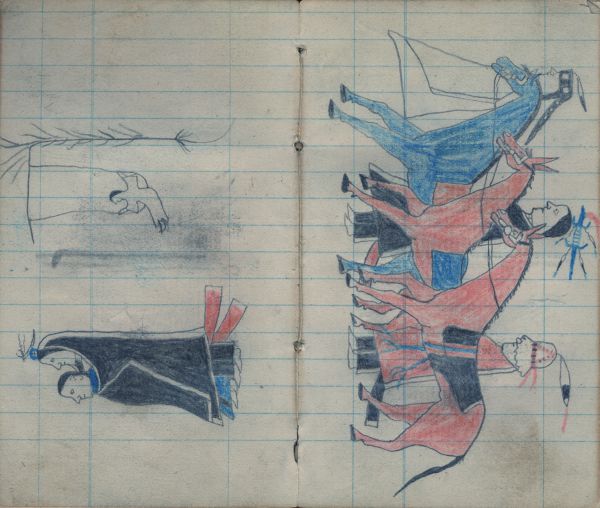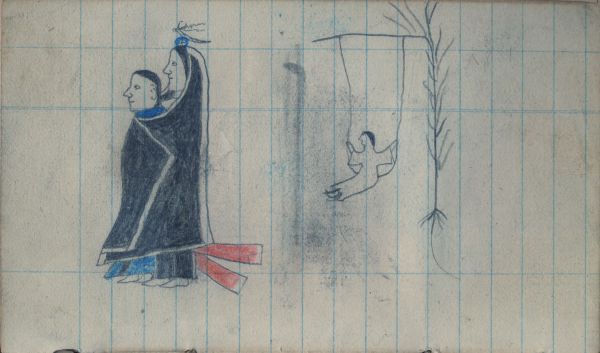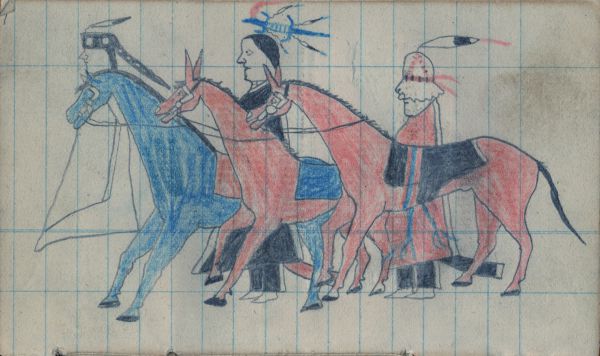Couple facing away from child in swing | Party of 3 men leading horses with headgear
Ethnographic Notes
Right Page: Nisson refers to one of the most important relationships in Cheyenne society---blood kin of the same sex and generation, either brothers and male first cousins, or sisters and female first cousins. Nisson relatives were one's closest supporters---playmates in childhood, and partners in life's later games of courting and warfare. Commonly, a nisson was composed of four age-mates formally bonded by their families.
Here, the artist has depicted himself and his nisson "brothers" on a group date with a young lady identified on the 1881 census as O-!J1!I.-als-sa-eh, Woman Going Up and Down, or Woman on a Swing. In 1887 she was the 16-year-old daughter of the widowed Slow Smoking Woman. The artist may be identified from the felt hat shown earlier on Page 29.
From his position as last in the stag line, we understand that he is the junior member of this nisson.
His older brothers/ cousins have borrowed their fathers' war talismans for prestige and good luck in this related enterprise. The eldest, shown on Page 64 having "first dibs" with the young lady, has an amulet shaped like a horned snake tied to his scalp lock. The sibling in second position, at head of the line on Page 63, wears an otter fur turban decorated with silver conchos or circular trade mirrors, and an eagle feather.
The sibling in third position, at the center of Page 63, has tied to his scalp lock the beaded effigy of a swift-moving lizard. This is remarkably similar in form and attachments to an actual lizard effigy which was collected at Darlington Agency in 1885, almost exactly 12
when this drawing was made (Figure 8). That amulet had belonged to the Northern Cheyenne chief Morning Star, called Dull Knife. Apparently it was left with relatives at Darlington Agency when Dull Knife and Little Wolf had led the Northern Cheyenne exodus back to Montana in 1878-79. It is not known how, or from whom, the Agent Daniel B. Dyer acquired Dull Knife's lizard talisman. Such amulets were commonly made in sets, commissioned by the members of a nisson from some senior, visionary warrior. If the amulet represented on Page 63 were the actual one collected by Dyer, then the ledger could have been made no later than 1885, when the amulet was collected. I see no way to determine this with certainty, and the discrepancy is only two years anyway. The lizard depicted on Page 63, however, might well have been a matching amulet, commissioned at the same time as the one belonging to Dull Knife (say, sometime in the 1860s), and belonging to another member of his nisson. In either event, the artist appears to have been the son of one of Dull Knife's brothers, or first cousins. This indirect clue might be the key to deciphering his identity.
A further clue to the artist's identity is that the man shown at center on Page 63 (Figure 7), wearing the lizard amulet tied to his scalp lock, may be the same relative with whom the artist shows himself "double dating" on Page 38. AJI of the man's clothing appears to be the same in both drawings; and he is "paired" with the artist on both occasions, probably because they were the youngest members of their nisson. On Page 38 this man is given a name glyph which may be "Striped Wolf', or "Striped-face Wolf'. If this individual could be located on one of the census lists, in Agency records, or in another ledger collection, his identity and close associates could aid in identifying his younger sibling, the artist of this collection.
,.-, The four nisson brothers have arrived for this date riding a horse (at left), and a pair of mules, indicated by their much longer ears. Another mule is depicted on Page 81. The three equines in Figure 7 are dressed in expensive headstalls decorated with plaques and conchos of nickel silver. Compare an actual headstall of this type shown in the 1891 photo in Figure 9. Some of these were made by Indian artists, but most were obtained in trade from frontier silversmiths, primarily Mexican. These silver decorations were often elaborated with stamped designs, and rocker engraving.


